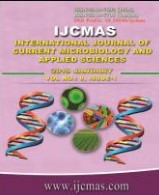


 National Academy of Agricultural Sciences (NAAS)
National Academy of Agricultural Sciences (NAAS)

|
PRINT ISSN : 2319-7692
Online ISSN : 2319-7706 Issues : 12 per year Publisher : Excellent Publishers Email : editorijcmas@gmail.com / submit@ijcmas.com Editor-in-chief: Dr.M.Prakash Index Copernicus ICV 2018: 95.39 NAAS RATING 2020: 5.38 |
Nowadays, synthetic dyes are widely used in textile, leather, cosmetics, paper, food and pharmaceutical industries instead of natural dyes due to its availability, stability, low cost and color intensity which emerges a new problem of residual color in the discharged effluent. Improper discharge of dye effluent in aqueous ecosystems is aesthetically unpleasant and impedes photosynthetic activity reducing sunlight penetration, dissolved oxygen concentration and water quality in total. Recalcitrant azo dyes which are mostly used in textile industries are not exhaustively removed from effluent by the existing effluent treatment plant. Biological method has gained momentum over physical and chemical process to remove color of dyes because of economic viability, ecofriendly and suitable for wide range of dyes. This review primarily focuses on color removal efficiency of different organisms, its mechanism and several responsible physicochemical parameters for dye removal.
 |
 |
 |
 |
 |